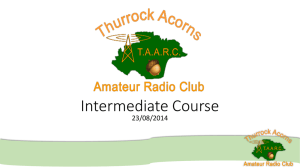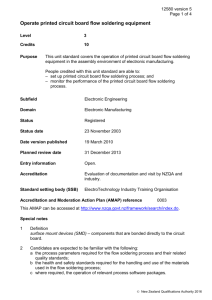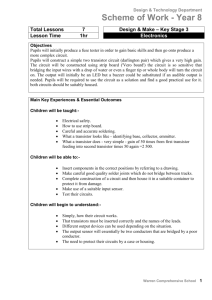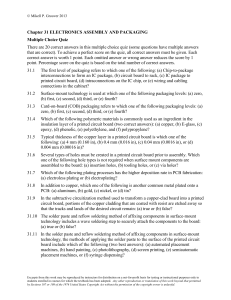Induction
advertisement
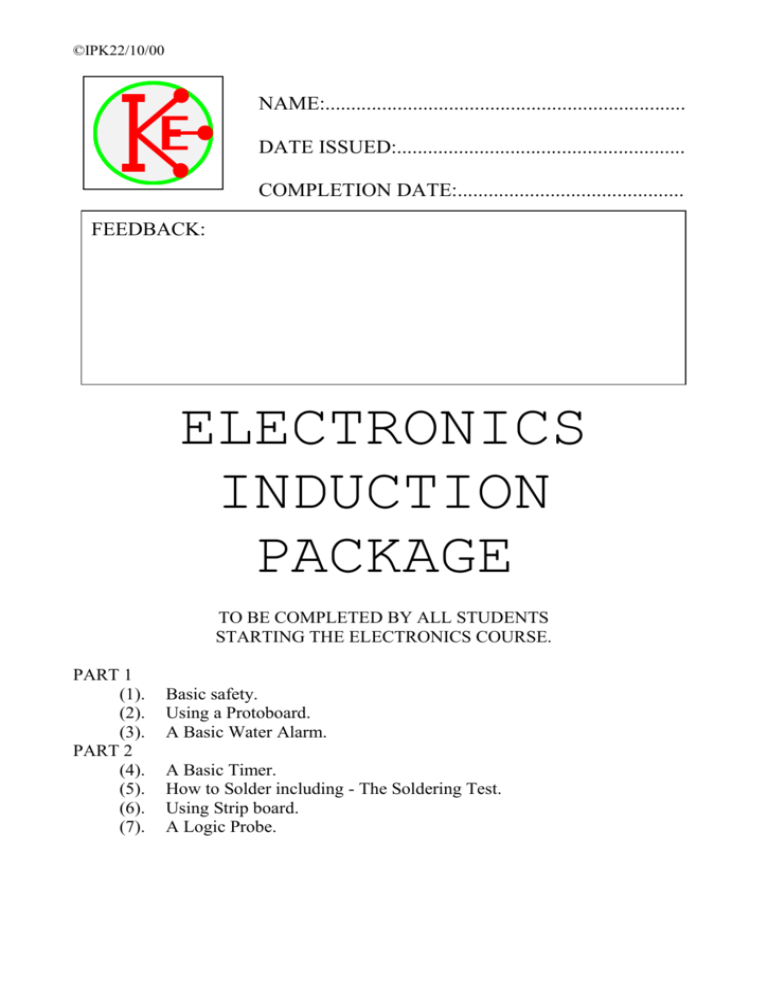
©IPK22/10/00 NAME:...................................................................... DATE ISSUED:........................................................ COMPLETION DATE:............................................ FEEDBACK: ELECTRONICS INDUCTION PACKAGE TO BE COMPLETED BY ALL STUDENTS STARTING THE ELECTRONICS COURSE. PART 1 (1). (2). (3). PART 2 (4). (5). (6). (7). Basic safety. Using a Protoboard. A Basic Water Alarm. A Basic Timer. How to Solder including - The Soldering Test. Using Strip board. A Logic Probe. ©IPK22/10/00 A).(1). *Basic safety. Read through the following passage and then complete the tasks below. Most of what you do in electronics is completely safe, but you should take great care when SOLDERING, when using CUTTING TOOLS and when using MAINS POWER. A hot soldering iron or hot solder can give a nasty burn. They typically will have a temperature between 200oC and 400oC. It can also burn through clothes and books. Soldering irons never look HOT and so you should always handle a soldering iron as if it was HOT. It should always be kept in a soldering iron holder when it is not actually being used for soldering. A soldering iron should never be left lying on a bench. The heat from a soldering iron can easily melt plastics. A soldering iron should be kept away from plastic cases, plastic components and the insulation of wires, especially the leads of mains powered equipment. Melting the insulation on mains cables is extremely dangerous. Work carefully so that there is no chance of hot solder getting into eyes or onto skin or clothes. Wear goggles of safety glasses. All burns are painful and should be immersed in cold water. Skin which has not blistered will be very sore for a few hours but will heal within a few days. Skin which has blistered will also be very sore and will take much longer to heal. Blisters should not be burst but should be allowed to heal naturally. If the skin has blisters which have burst then medical advice must be sought. All cutting tools, by definition, must be sharp! Tools designed for cutting metals will have little trouble cutting skin! Take special care when cutting wire with wire clippers since the pieces of wire could fly off into someone's eye. Take special care when cutting aluminium sheet since the edges can be very sharp. Use a file to remove all sharp edges. Take special care when drilling holes. Wear goggles or safety glasses to protect your eyes from swarf and also if the drill breaks. Ensure that what is being drilled is held down firmly and does not start to spin round with the drill. Use a large drill or a file to remove burr from holes drilled in metal sheets. Ensure that: (a) any mains powered equipment is used well away from any water or other liquids. Check that the plug and the mains cable are not damaged before connecting to the mains, (b) you do not place circuit boards or test equipment near the edge of a bench where they could easily be knocked onto the floor, (c) there are no cables placed across access ways that could cause someone to trip. 2 ©IPK22/10/00 Tasks 1). Of the many safety issues covered in the passage above, list the five that you consider to be the most serious and explain your choice. …………………………………………………………………………………………….. …………………………………………………………………………………………….. …………………………………………………………………………………………….. …………………………………………………………………………………………….. …………………………………………………………………………………………….. …………………………………………………………………………………………….. …………………………………………………………………………………………….. …………………………………………………………………………………………….. …………………………………………………………………………………………….. …………………………………………………………………………………………….. 2). State two safety issues that you feel students should consider when working with electronics and explain your choice. …………………………………………………………………………………………….. …………………………………………………………………………………………….. …………………………………………………………………………………………….. …………………………………………………………………………………………….. …………………………………………………………………………………………….. …………………………………………………………………………………………….. …………………………………………………………………………………………….. …………………………………………………………………………………………….. …………………………………………………………………………………………….. …………………………………………………………………………………………….. 3 ©IPK22/10/00 A).(2). Using Protoboard. The best way to learn electronics is to build circuits and investigate how they operate. To enable circuits to be built quickly, Push-In or Solderless Breadboards have been developed. These often have many different commercial names and shapes but they all work on the same principle, that of the wires of the components being pushed through holes in a plastic case and held tightly by a metal spring. The general name used for all of these boards is PROTOBOARDS. The layout of a typical protoboard is shown in the diagram below. 1 5 10 15 20 25 A A B C B C D E D E F F G H I G H I J J 1 5 10 15 20 25 Each hole on the board will accommodate one wire. The lines show which holes are joined together by the metal springs. The holes in the main body of the protoboard are joined vertically, with a gap in the middle to accommodate integrated circuits. The holes at the top and bottom of the board are joined horizontally and can be used as power supply lines. The first circuit that you are going to build uses a RESISTOR and a LIGHT EMITTING DIODE, which is usually referred to as a LED. Resistors. A resistor is a component that reduces the amount of electric current that flows. Use the Support Booklet and any practical equipment that you need to carry out the following tasks. 1). Examine a selection of resistors and draw sketches to show what they are like. 4 ©IPK22/10/00 2). Draw a labelled diagram to show the cross section of a resistor. 3). All electronic components are represented by symbols since they are easier to draw than pictures. Draw the symbol that is used to represent a resistor. 4). Name three types of resistors and describe their differences, advantages and disadvantages. …………………………………………………………………………………………….. …………………………………………………………………………………………….. …………………………………………………………………………………………….. …………………………………………………………………………………………….. …………………………………………………………………………………………….. …………………………………………………………………………………………….. 5). What is the unit of resistance? …………………………………………………………………………………………….. 6). Explain what is meant by a PREFERRED VALUE. …………………………………………………………………………………………….. …………………………………………………………………………………………….. …………………………………………………………………………………………….. 7). Explain what is meant by the tolerance of a resistor. …………………………………………………………………………………………….. …………………………………………………………………………………………….. …………………………………………………………………………………………….. 5 ©IPK22/10/00 8). The value of a resistor is often marked onto the resistor using coloured bands. What would be the value of a resistor having a yellow, a purple, a brown and a gold band? This is the resistor that you will need for the practical work. …………………………………………………………………………………………….. …………………………………………………………………………………………….. Light Emitting Diode or LED. A LED is a small semiconductor component that will emit light when an electric current passes. 1). Examine a LED and draw a sketch. Remember to show one lead longer than the other and also the small flat part on the one side of the body. 2). Draw the symbol for a LED. 3). How many volts are needed across a LED to make it light? …………………………………………………………………………………………….. 4). How much current should flow through a LED? …………………………………………………………………………………………….. 5). State three uses of LEDs. …………………………………………………………………………………………….. …………………………………………………………………………………………….. …………………………………………………………………………………………….. 6). What are the advantages of LEDs compared to normal lamps? …………………………………………………………………………………………….. …………………………………………………………………………………………….. …………………………………………………………………………………………….. 6 ©IPK22/10/00 Practical Work. +9V 1). The diagram of the circuit that you are going to construct is shown opposite. Label the components. 470 2). Collect a protoboard, LED and a correctly coloured resistor. Decide how you are going to arrange them on your protoboard to construct the circuit. DO NOT pull the leads of the LED too far apart, or they will break! Use a battery connector to connect your circuit to a 9V battery. Ensure that your circuit is correct before connecting it to the 9 volt power supply. Mark onto the diagram of the protoboard where you have inserted the components. 1 5 10 15 20 0V 25 A A B C B C D E D E F F G H I G H I J J 1 5 10 15 20 25 3). If all is well the LED should light. If it does not check your work. 4). What happens if the power supply is connected the other way round to your circuit? …………………………………………………………………………………………….. …………………………………………………………………………………………….. 5). Explain the purpose of the resistor. …………………………………………………………………………………………….. …………………………………………………………………………………………….. 7 ©IPK22/10/00 A).(3). A Basic Water Alarm. This assignment introduces Integrated Circuits, (ICs). An IC consists of a tiny piece of silicon onto which complex circuits are fabricated directly. Putting circuits into IC form has many advantages, the main one for the user is that very complex circuits can be constructed quickly by using ICs as building blocks. The IC used in this assignment is a digital circuit. It contains six separate NOT gate circuits and it is one of these that will be used for the Water Alarm. The serial number of the IC is 4049UB. The IC has 16 pins for connections. The diagram below shows the connections to the pins of the IC looking down from the top. NC NC 4049UB 1 +Vs 0V NC means that there is No Connection to that pin (terminal). +Vs is the positive connection and 0V is the negative connection to the power supply/battery. The symbol for a NOT gate is input output Each of the NOT gates of the IC are identical, so any can be used for the following circuits. However, the NOT gates are easily damaged by static electricity and so ALL of the unused inputs should be connected to 0V connection to the battery. For the circuits that follow, the IC should be carefully placed across the centre of your protoboard, as in the diagram below. 1 5 10 15 20 25 A A B C B C D E D E 4049UB F F G H I G H I J J 1 5 10 15 20 25 The protoboard, resistor and LED were introduced in the last assignment. This assignment introduces the NOT gate, which is an ACTIVE component (i.e. it can amplify). Using the NOT gate you will build a circuit that can act as a Water Level Alarm. 8 ©IPK22/10/00 It is customary not to mark the power supply connections to the IC on the circuit diagram but to assume that they are connected. DO NOT FORGET TO MAKE THESE CONNECTIONS WHEN CONSTRUCTING YOUR CIRCUITS Label the components in the circuit diagram below. +9V A R2 Input wire R1 0V 1). R1 is a 1M, 5% resistor. Write down the coloured bands that the resistor will have. …………………………………………………………………………………………….. …………………………………………………………………………………………….. 2). R2 is a 470, 5% resistor. Write down the coloured bands that the resistor will have. …………………………………………………………………………………………….. …………………………………………………………………………………………….. 3). Draw on the protoboard diagram below (in pencil) an arrangement for how the components can be arranged to construct the circuit. You can use any of the NOT gates in the IC, but remember to connect all of the unused inputs to 0V. Check the design with your supervisor before continuing. 1 5 10 15 20 25 A A B C B C D E D E F F G H I G H I J J 1 5 10 15 9 20 25 ©IPK22/10/00 4). Collect the components and carefully construct the circuit on a protoboard, following your design on the planning sheet. Use single core wire for making other connections on the protoboard. Check the design with your supervisor before continuing. 5). Connect a 9V battery to the circuit. Ensure that the positive wire (RED) is connected to the positive terminal and the negative wire (BLACK) to the negative terminal. Switch on. What happens? …………………………………………………………………………………………….. 6). Connect another piece of wire to the positive line and touch the free end onto the free end of the INPUT wire. Switch on. What happens this time? …………………………………………………………………………………………….. 7). Fetch a beaker of water and touch the free ends of the two wires into the water. Explain what happens this time. Use the support booklet to help you. What is the NOT gate acting as? …………………………………………………………………………………………….. …………………………………………………………………………………………….. …………………………………………………………………………………………….. …………………………………………………………………………………………….. …………………………………………………………………………………………….. …………………………………………………………………………………………….. 8). Explain how this circuit could be used as a water level alarm to prevent a bath being overfilled. How could you improve this basic circuit? …………………………………………………………………………………………….. …………………………………………………………………………………………….. …………………………………………………………………………………………….. …………………………………………………………………………………………….. …………………………………………………………………………………………….. …………………………………………………………………………………………….. 10 ©IPK22/10/00 A).(4). A Basic Timer. This task is to give an introduction to capacitors and their use in electronic timing circuits. Use the Support Booklet and any practical equipment that you need to carry out the following tasks. The Capacitor. 1). A capacitor stores electric charge (electricity). Examine a selection of capacitors and draw and label sketches to show the different types. 2). Draw a labelled diagram to show the construction of a capacitor. Draw the symbols that are used to represent capacitors. 11 ©IPK22/10/00 3). What is the unit of capacitance? …………………………………………………………………………………………….. 4) (a) The two main types of capacitor available are Polyester and Electrolytic. What are the differences between them? …………………………………………………………………………………………….. …………………………………………………………………………………………….. (b) What special care must you take when using electrolytic capacitors? …………………………………………………………………………………………….. …………………………………………………………………………………………….. (c) The circuit diagram for the timer is shown below. Label the components. +9V A R2 Input wire + R1 C 0V 5). On a protoboard diagram below draw (in pencil) an arrangement for how the components can be arranged for the circuit of the timer shown above. Check your design before continuing. 1 5 10 15 20 25 A A B C B C D E D E F F G H I G H I J J 1 5 10 15 12 20 25 ©IPK22/10/00 6). R1 is a 10k resistor. What coloured bands does it have? …………………………………………………………………………………………….. R2 is a 470 resistor. What coloured bands does it have? …………………………………………………………………………………………….. C is a 100F electrolytic capacitor. Ensure that it is connected the correct way round. Collect the components and carefully construct the circuit on a protoboard by following your design on the protoboard diagram. Use single core wire for making other connections on the protoboard. Check your design before continuing. 7). Connect a 9V battery to the circuit. Ensure that the positive wire (RED) is connected to the positive terminal and the negative wire (BLACK) to the negative terminal. Switch on. What happens? …………………………………………………………………………………………….. …………………………………………………………………………………………….. 8). Connect the input wire onto the positive supply line. What happens? …………………………………………………………………………………………….. Now disconnect the input wire from the positive supply line. What happens? …………………………………………………………………………………………….. How long does the LED remain lit after the input wire has been disconnected? …………………………………………………………………………………………….. …………………………………………………………………………………………….. 9). Replace the 10k resistor with a 100k resistor. What coloured bands does it have? …………………………………………………………………………………………….. How long does the LED remain lit after the input wire has been touched onto the positive supply line? …………………………………………………………………………………………….. 10) Replace the electrolytic capacitor with a larger value. Note the value of this larger capacitor and also how long the LED remained lit after the input wire had been disconnected from the positive supply line. …………………………………………………………………………………………….. …………………………………………………………………………………………….. 13 ©IPK22/10/00 11). Use the Support Booklet to explain how the circuit is working as a timer. What is the purpose of the capacitor in the circuit? …………………………………………………………………………………………….. …………………………………………………………………………………………….. …………………………………………………………………………………………….. …………………………………………………………………………………………….. …………………………………………………………………………………………….. …………………………………………………………………………………………….. …………………………………………………………………………………………….. …………………………………………………………………………………………….. 13). Explain how such a circuit could be used as an Egg timer. Find out how long an egg should be boiled for. Suggest values for the capacitor and input resistor, R1, that will give this time. …………………………………………………………………………………………….. …………………………………………………………………………………………….. …………………………………………………………………………………………….. …………………………………………………………………………………………….. …………………………………………………………………………………………….. …………………………………………………………………………………………….. …………………………………………………………………………………………….. …………………………………………………………………………………………….. 14 ©IPK22/10/00 A).(5). How to Solder. Read through the paragraphs below and then answer the questions. Successful soldering Soldering is a technique that is employed in electronics to provide reliable, low resistance connections between wires and components. Solder is not intended to be a type of glue or a filler (although it will actually do these jobs quite successfully.) Solder is an alloy (mixture of two or more metals) made from tin and lead in the ratio of 3:2. It melts at a temperature of approximately 200oC and will make good connections to copper, brass, tin, silver and gold. solder flux The solder used for electronic work comes as soldering wire in two main sizes, 18 SWG or 22 SWG. As well as the solder it also contains a flux which helps the solder to flow more readily onto the metal surfaces. A diagram showing the cross section of solder is shown in figure opposite. The flux melts along with the solder and appears as a 'smoke'. This 'smoke' should not be inhaled since it can cause respiratory irritations. For metals to be soldered they must be clean and free from any grease or corrosion. A soldering iron suitable for modern electronics work will have a power rating of 15W and a small 'bit' with a diameter of 2mm to 4mm. The bit is made from copper and is coated with tin. It will reach a temperature of up to 350oC and, in normal use, will last a long time. It will become coated with black material (often copper oxide or burnt grease) and should be cleaned by being wiped with a damp sponge. The tip of the bit of the soldering iron should be kept coated with a thin layer of solder and so after it has been cleaned it should be touched onto the soldering wire to coat it. This process is known as tinning. For two metals to be joined by solder it is important to ensure that both metals and the solder are at a temperature above which the solder melts. Soldering wires to terminal connections The wire is passed through the hole in the terminal. It should not be wrapped around the terminal unless you are absolutely certain that you soldering iron will never want to remove it again! The bit of the soldering iron should be placed against the terminal and the wire until they are hot enough to melt solder (two or three seconds) and then solder should be applied. If all is at the right temperature then wire bit the solder will be seen to melt and flow onto the wire and terminal. Sufficient solder should be used to completely cover the terminal hole terminal and the wire where it passes through the terminal. When this has happened, the solder wire should be removed and then the soldering iron should be removed. It will take a few seconds for the metals to cool sufficiently for the solder to freeze, but it could remain hot enough to cause burns for several minutes afterwards. 15 ©IPK22/10/00 Soldering wires to circuit boards A similar process is used to that for soldering to terminal connections. The wire is passed through the hole in the circuit board. The bit of the soldering iron is placed against the circuit board copper and the wire for one or two seconds and then solder is applied to the bit of the iron. If all is at the right temperature then the solder will be seen to melt and flow onto the wire and the circuit board copper. Sufficient solder should be used to completely cover the circuit board hole and the wire where it passes through the hole. When this has happened, the soldering wire should be removed and then the soldering iron should be removed. It will take a few seconds for the metals to cool sufficiently for the solder to freeze, but it could remain hot enough to cause burns for several minutes afterwards. soldering iron circuit board copper wire bit circuit board Common soldering faults 1). Symptom: Cause: Remedy: The wire is coated with solder but the circuit board copper is not. The soldering iron did not warm the copper of the circuit board sufficiently. Reheat the copper board and the wire and apply some more solder. 2). Symptom: Cause: Remedy: The circuit board copper is coated with solder but the wire is not. The soldering iron did not warm the wire sufficiently. Reheat the circuit board copper and the wire and apply some more solder. 3). Symptom: The wire appears to be soldered correctly but it has formed a high resistance joint. This is known as a DRY JOINT and is caused either by dirt on the wire or the wire not being heated sufficiently. Reheat the copper board and the wire and apply some more solder. If the joint still has a high resistance then the wire should be removed and cleaned before being re soldered. Cause: Remedy: The timing for soldering components, especially semiconductors, is very important. If the wire and circuit board are not adequately heated then a poor joint will result. If the wire and circuit board are heated too much then there is a great danger of damaging the component. Semiconductor devices will usually withstand the heat of a soldering iron for about 2 seconds. Quick, careful and effective soldering is vital. If you are uncertain how quickly you will be able to solder a delicate (or expensive) component, a Heat Shunt should be used to conduct the heat away from the component. A pair of small nose pliers will act as a convenient heat shunt for components with leads, eg transistors. The lead being soldered is held with the pliers. Excessive heat is then conducted to the pliers instead of the transistor. Solder should NEVER be applied to the bit of the soldering iron and then transported to the wire and circuit board copper. At the best, the solder joint will be of very poor quality because the flux needed to help the solder flow will have burnt off from the soldering iron while the molten solder was being transported. Solder should only be applied to the hot wire and copper when they have been heated by the soldering iron. 16 ©IPK22/10/00 1). What is solder made from? …………………………………………………………………………………………….. 2). At what temperature does solder melt? …………………………………………………………………………………………….. 3). Name three metals that can be soldered. 4). …………………………………………………………………………………………….. Suggest a reason why the surfaces to be soldered must be cleaned if they are greasy or corroded. …………………………………………………………………………………………….. 5). …………………………………………………………………………………………….. How should the soldering iron bit be cleaned if it is dirty? Why should you never file the soldering iron bit to clean it? …………………………………………………………………………………………….. …………………………………………………………………………………………….. 6). Explain, in your own words, how to solder a wire onto a piece of copper. Draw diagrams to help if you wish. …………………………………………………………………………………………….. …………………………………………………………………………………………….. …………………………………………………………………………………………….. …………………………………………………………………………………………….. …………………………………………………………………………………………….. …………………………………………………………………………………………….. 7). Suggest a reason why it is necessary to ensure that solder has flowed onto both of the surfaces to be joined? …………………………………………………………………………………………….. …………………………………………………………………………………………….. …………………………………………………………………………………………….. 8). What happens to the components being soldered if heat is applied to them for too long? …………………………………………………………………………………………….. 17 ©IPK22/10/00 9). What is a HEAT SHUNT and how is it used? …………………………………………………………………………………………….. …………………………………………………………………………………………….. 10). What components are most likely to suffer damage from excess heat? …………………………………………………………………………………………….. 11). Why should work that has been freshly soldered not be touched. …………………………………………………………………………………………….. 12). Explain briefly why wearing goggles or safety glasses is a sensible safety precaution when soldering. …………………………………………………………………………………………….. …………………………………………………………………………………………….. 13). Explain briefly what you should do if you burn yourself with a soldering iron? …………………………………………………………………………………………….. …………………………………………………………………………………………….. …………………………………………………………………………………………….. …………………………………………………………………………………………….. 14). Explain why hot soldering irons should not be left lying on a bench but should be returned to a soldering iron stand. …………………………………………………………………………………………….. …………………………………………………………………………………………….. 18 ©IPK22/10/00 A).(6). Stripboard and the Soldering Test. STRIPBOARD. While protoboards provide a very quick means of assembling and testing circuits, they do not provide a reliable circuit for normal use. Printed circuit boards provide the most reliable means of ruggedly constructing circuits but the design of the circuit board can take a long time and is not easily modified. A more convenient way to produce rugged and reliable circuits is to use stripboard. The diagram below shows a piece of stripboard viewed from the bottom. It consists of a sheet of SRBP board punched with holes every 0.1 inch and with strips of copper foil running horizontally. These copper foil tracks are used to make connections between the components by soldering the components to the copper tracks. In use, the components would be placed on the TOP side of the board with the wires poked through the holes. The wires are then soldered to the copper track and the excess wire removed. THE SOLDERING TEST. Since the strips on stripboard are only 0.1 inches apart it is very easy to spread solder from one strip to another. This causes short circuits and is of little use. This test is to give you practice at soldering to strip board. Obtain an offcut of strip board and solder six wires to adjacent copper strips along the edge of the board. Seek assistance from your supervisor if you have difficulty with this task. When completed have your work assessed by your supervisor and attach the sample to your Induction Booklet. Supervisor Signature:......................................................................................................................... Date:................................................................................................................................................... 19 ©IPK22/10/00 A).(7). The Logic probe. In this section you are going to make a Logic probe for use with the next section of work. A Logic Probe is used to indicate the logic state of a point in a circuit. If the voltage at the point is greater than half of the supply voltage a red LED will light and if it is less than half of the supply voltage a green LED will light. If it is not connected then neither of the LEDs will light. The circuit diagram for the Basic Logic Probe is shown below together with a strip board layout. Examine the circuit diagram and layout carefully. It is very difficult to correct errors if you make mistakes. 10R 470R + pin 1 High red +Vs 10F 1N4001 470k 5 probe 100k 1M 4 4049UB 1M 7 6 green Low pin 8 470R 0V red + + 4 7 0 R probe 1 0 R 4049UB 470k 100k + green 1 M 1 4 M 7 0 R + 10F _ 1N4001 10 strips by 24 holes Collect all of the components that you need, including the piece of strip board and fit the components onto the circuit board EXACTLY as shown in the diagram above. Check your layout with someone else to ensure that it is correct. 20 ©IPK22/10/00 When you are certain that all of the components are correctly located carefully break the copper track of the strip board as shown in the diagram, using a Strip Cutting tool. Carefully solder all of the components in place. Attach a thick piece of wire to form a probe and some twin wire to supply the power. Connect crocodile clips to the free end of the power cable. Attach your battery to the power cable and check that no LEDs light. If they do check your wiring. Touch the probe to the positive terminal of the battery, the RED LED should light. If it does not, check your wiring. Touch the probe to the 0V terminal of the battery, the GREEN LED should light. If it does not, check your wiring. When you are satisfied that your Logic Probe is working correctly demonstrate its function to your supervisor. Supervisor signature…………………………………………….Date…………………….. If you have insufficient time to add the pulse detector then you should add wires to connect: pin 3 to pin 1, pin 14 to pin 16, pin 9 to the bottom strip of the board. This will ensure that all of the unused inputs are connected safely. Ensure that your logic probe still works. Make a list of the components that you have used and then, using component catalogues, calculate the cost of your logic probe. …………………………………………………………………………………………….. …………………………………………………………………………………………….. …………………………………………………………………………………………….. …………………………………………………………………………………………….. …………………………………………………………………………………………….. …………………………………………………………………………………………….. …………………………………………………………………………………………….. …………………………………………………………………………………………….. …………………………………………………………………………………………….. …………………………………………………………………………………………….. 21 ©IPK22/10/00 PULSE DETECTOR Sometimes a logic circuit will generate very short voltage pulses that can be a nuisance. The pulse detector will make these visible by making a yellow LED flash when there is a high to low, or low to high change of voltage on the logic probe input. The complete circuit diagram is shown below, including the basic probe circuit. 10R 470R + 10F pin 1 High red probe 100k 1M 1N4001 4049UB 470k 5 +Vs 4 100k 1M 1N4148 2 3 7 6 green Low 100nF 11 10 9 15 14 470R 12 yellow pulse 1M pin 8 470R 0V yellow 1N4148 1N4148 red + + 4 7 0 R probe + 1 0 R 4049UB 470k 100k + green 1 M 1 4 M 7 0 R 1 M 1 0 0 K 4 7 0 R + 10F _ 100nF 1N4001 10 strips by 24 holes List the additional components that you need. …………………………………………………………………………………………….. …………………………………………………………………………………………….. …………………………………………………………………………………………….. …………………………………………………………………………………………….. 22 ©IPK22/10/00 Collect these components and carefully add them to your circuit board. Make all of the additional strip breaks that are required. Carefully solder the components onto the board. Check for errors. When it is completed connect your battery to the power wires. No LEDs should light. Touch the probe onto the positive terminal of the battery. The red LED should light and the yellow LED should flash. Touch the probe onto the 0V terminal of the battery. The green LED should light and the yellow LED should flash. When it is working correctly, demonstrate the probe to your supervisor. Supervisor signature…………………………………………….Date…………………….. Calculate the additional cost of the components for the pulse detector, remembering that you do not need another IC. …………………………………………………………………………………………….. …………………………………………………………………………………………….. …………………………………………………………………………………………….. …………………………………………………………………………………………….. …………………………………………………………………………………………….. …………………………………………………………………………………………….. …………………………………………………………………………………………….. …………………………………………………………………………………………….. …………………………………………………………………………………………….. …………………………………………………………………………………………….. 23


